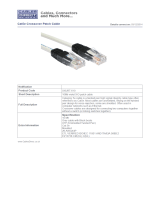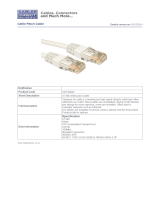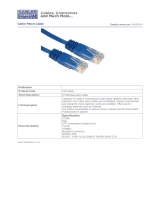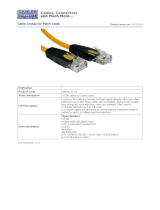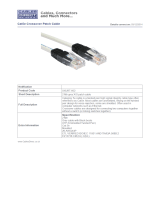Page is loading ...

UR Switch Module
Ethernet Communications
Switch
Quickstart Guide
Firmware Revision 3.x
Manual P/N: 1601-9042-A1
Manual Order Code: GEK- 113423
Copyright © 2008 GE Multilin
GE Multilin
215 Anderson Avenue, Markham, Ontario
Canada L6E 1B3
Tel: (905) 294-6222 Fax: (905) 201-2098
Internet: http://www.GEmultilin.com
*1601-0220-A1*
I
ISO9001:2000
G
E
M
U
L
T
I
L
I
N
R
E
G
I
S
T
E
R
E
D
GE Multilin's Quality
Management System is
registered to ISO9001:2000
QMI # 005094
UL # E83849
GE Consumer & Industrial
Multilin

These instructions do not purport to cover all details or variations in equipment nor provide
for every possible contingency to be met in connection with installation, operation, or
maintenance. Should further information be desired or should particular problems arise
which are not covered sufficiently for the purchaser’s purpose, the matter should be referred
to the General Electric Company.
To the extent required the products described herein meet applicable ANSI, IEEE, IEC, and UL
standards; but no such assurance is given with respect to local codes and ordinances
because they vary greatly.
© 2008 GE Multilin Incorporated. All rights reserved.
GE Multilin UR Switch Module Quickstart Guide for revision 3.x.
UR Switch Module is a registered trademark of GE Multilin Inc.
The contents of this manual are the property of GE Multilin Inc. This documentation is
furnished on license and may not be reproduced in whole or in part without the permission
of GE Multilin. The content of this manual is for informational use only and is subject to
change without notice.
Part numbers contained in this manual are subject to change without notice, and should
therefore be verified by GE Multilin before ordering.
Part number: 1601-9042-A1 (June 2008)

TABLE OF CONTENTS
UR SWITCH MODULE – QUICKSTART GUIDE TOC–1
Table of Contents
INTRODUCTION TO TWISTED PAIR AND FIBER OPTIC ETHERNET LANS ............QS-1
E
THERNET PHYSICAL LAYER: TWISTED PAIR COPPER VS FIBER OPTIC ........................ QS-1
Twisted Pair copper cable ............................................................................. QS-2
Fiber ......................................................................................................................... QS-2
SUPPORTED NETWORK TOPOLOGIES ................................................................................ QS-3
Star Architecture ................................................................................................ QS-3
Mesh Architecture ............................................................................................. QS-3
Ring Architecture ............................................................................................... QS-3
10BASET AND 100BASET MEDIA ...................................................................................QS-4
Unshielded Twisted Pair cable: ................................................................... QS-4
Ethernet: Unshielded Twisted Pair ............................................................. QS-4
HUBS AND SWITCHES ......................................................................................................QS-7
F
IBER OPTIC ETHERNET: ..................................................................................................... QS-7
Wavelengths of light ........................................................................................ QS-7
SINGLE AND MULTI-MODE CABLE ..................................................................................... QS-8
Fiber Cable Cross Section and Physical Specifications ................... QS-8
Difference between Single-mode and Multi-mode Cable .............. QS-9
OPTICAL POWER BUDGET .................................................................................................. QS-9
M
AXIMUM FIBER SEGMENT LENGTH CALCULATION: ........................................................ QS-11
UR-2S
AND UR-2T 10/100 BASET SWITCH PORTS .................................................. QS-12
INTRODUCTION TO THE 2S AND 2T UR MANAGED SWITCH MODULES: ............QS-13
H
ARDWARE OVERVIEW ....................................................................................................... QS-15
2S
AND 2T LED INDICATORS ............................................................................................ QS-15
H
ARDWARE INSTALLATION ................................................................................................. QS-16
INITIAL CONFIGURATION PROCEDURE ............................................................................. QS-17
C
ONFIGURING THE SWITCH IP ADDRESS AND SUBNET MASK USING
E
NERVISTA UR SETUP SOFTWARE. ................................................................ QS-17
A
SSIGNING AN IP ADDRESS TO THE UR SWITCH MODULE
USING THE CONSOLE PORT ............................................................................. QS-19
A
SSIGNING A STATIC IP ADDRESS TO A PERSONNEL COMPUTER .................................. QS-26
S
ELF-TEST ERRORS AND MEANING ................................................................................... QS-31
TAGGED VLAN’S .................................................................................................................QS-33
Background .......................................................................................................... QS-33
CONFIGURING TAGGED VLANS ........................................................................................ QS-34
Configuring a VLAN within the Switch ..................................................... QS-34
CONFIGURING THE UR SWITCH FOR RING ONLY MODE .............................................. QS-40
S
AVING AND LOADING SWITCH SETTINGS ...................................................................... QS-49
Saving Switch Settings .................................................................................... QS-49
Loading Switch Settings ................................................................................. QS-49
UR SWITCH MODULE FIRMWARE UPDATES ...............................................................QS-51
U
PDATING UR SWITCH MODULE FIRMWARE ................................................................. QS-51
S
ELECTING THE PROPER VERSION .................................................................................... QS-51

TOC–2 UR SWITCH MODULE – QUICKSTART GUIDE
TABLE OF CONTENTS

UR SWITCH MODULE – QUICKSTART GUIDE QS–1
UR Switch Module
Ethernet Communications Switch
QuickStart Guide
GE Consumer & Industrial
Multilin
QuickStart Guide
QS.1 Introduction to Twisted Pair and Fiber Optic Ethernet
LANs
This section will provide a brief review of modern Ethernet media, before covering the steps
used to configure the Multilink switch for typical protective relaying applications. For this
discussion the IP addresses that will be used, are in the range of 3.94.247.1 to 3.94.247.254
using a subnet mask of 255.255.252.0. This same range of addresses can be used for
testing purposes but you should contact your IT support group for a valid range of
addresses to be used for your particular application.
QS.1.1 Ethernet Physical Layer: Twisted Pair Copper vs Fiber Optic
Today, the two most popular physical layer standards for Ethernet are twisted pair copper
cable and fiber optic cable. Twisted pair copper cable is easier to terminate, and has a
lower installation cost, but is susceptible to electrical noise. In addition, a single run of
twisted pair cable is distance-limited.
Fiber optic media can typically be applied over much longer distances, is immune to
electrical noise, and, while being more difficult to terminate, the availability of pre-
fabricated cables has dramatically reduced the complexity of installation within the
substation.

QS–2 UR SWITCH MODULE – QUICKSTART GUIDE
QUICKSTART GUIDE
Twisted Pair copper cable
• Easy to Terminate
• Low installation costs
• Susceptible to noise interference
• Limited to 100m
• Either shielded or unshielded (UTP)
Fiber
• Longer distances possible, limited only by attenuation
• Immune to electrical noise
• More difficult termination and splicing
• Slightly higher cost for cable
• Two categories:
• multi-mode
• single-mode

QUICKSTART GUIDE
UR SWITCH MODULE – QUICKSTART GUIDE QS–3
QS.1.2 Supported Network Topologies
With both media, supported topologies include Star, Mesh, and Ring. The port that
connects one switch to another is often called the uplink port and with many switches the
uplink port can operate at much higher baud rates than the standard ports. The link
formed by the connection of several switches’ higher speed uplink ports is often referred to
as a backbone.
Star Architecture
• Single point of failure before loss of communications
• Additional Ethernet Switches Required
Mesh Architecture
• Multiple points of failure required before loss of communications
• Additional Fiber Cables required
Ring Architecture
• Full Network Redundancy
• Allows for Fastest Network Recovery
*
• Most Cost Effective Solution
* RO mode has typical recovery time of
≤
5 ms/hop.
Ring
Mesh
Star

QS–4 UR SWITCH MODULE – QUICKSTART GUIDE
QUICKSTART GUIDE
QS.2 10BaseT and 100BaseT Media
10BaseT and 100BaseT are the two most common twisted pair copper media standards.
There are also several popular fiber optic media standards which we will review later in this
section. With respect to 10 or 100BaseT, the 10 or 100 designation indicates a baud rate of
either 10 or 100 megabits per second (Mbs). Base stands for baseband while the T stands
for twisted pair.
Since many twisted pair interfaces can work at either baud rate the designation 10/
100BaseT has evolved to indicate this capability. Cable can be either unshielded twisted
pair (UTP) or shielded twisted pair (STP).
We recommend category 5e (see below) for applications up to 1000 Mbs.
Unshielded Twisted Pair cable:
• Category 1: Used for telephone communications; not suitable for transmitting
data.
• Category 2: Capable of transmitting data at speeds of up to 4 Mbps.
• Category 3: Can be used in 10BaseT networks; can transmit data at speeds up to
10 Mbps.
• Category 4: Used in Token Ring networks; can transmit data at speeds up to 16
Mbps.
• Category 5: Capable of transmitting data at speeds up to 100 Mbps.
• Category 5e*: Used in networks running at speeds up to 1000 Mbps (1 Gbps).
• Category 6: Consists of four pairs of 24-gauge copper wires, which can transmit
data at speeds of up to 1000 Mbps.
* Recommended
Ethernet: Unshielded Twisted Pair
:
100 metres max.

QUICKSTART GUIDE
UR SWITCH MODULE – QUICKSTART GUIDE QS–5
FIGURE QS–1: Pin Layout for a RJ45 Ethernet Straight-through Cable
The cable itself consists of four pairs of wires terminated in RJ45 connectors. The
maximum permitted cable length is 100 meters. The cable pin connections can be one of
two configurations: the first is called a "straight-through" cable and the second is called
either a "crossover" or "patch" cable.
Given that the UR-2S/2T supports autonegotiate, a straight-through or crossover cable
may be used to connect or establish a point-to-point Ethernet LAN between two Ethernet
devices, as shown here.
100 metres max length
RJ45 Connectors

QS–6 UR SWITCH MODULE – QUICKSTART GUIDE
QUICKSTART GUIDE
FIGURE QS–2: Pin Layout for RJ45 Ethernet Crossover (Patch) Cable
The pin and wire configuration of a patch or crossover cable used to connect or establish a
point-to-point Ethernet LAN between two Ethernet devices, is shown above.

QUICKSTART GUIDE
UR SWITCH MODULE – QUICKSTART GUIDE QS–7
QS.3 Hubs and Switches
Two of the major Ethernet network components are hubs and switches. A switch has
many advantages over a hub. Hubs simply transfer information from one port to all other
ports. Since a hub has no way of handling media contention, collisions can occur,
necessitating all segments connected to a hub to work in a half-duplex mode.
Switches on the other hand, are capable of buffering messages, thus allowing full duplex
operation. A switch will also learn the MAC addresses of devices connected to each of it’s
ports and will then route messages to only that port to which the destination device is
connected, thereby reducing data traffic on the network. Switches that use configuration
software to customize both switch and traffic are called “managed switches.” Other
switches - ones that have fixed configurations - are referred to as “unmanaged switches.”
QS.3.1 Fiber Optic Ethernet:
Fiber optic Ethernet is rapidly becoming the medium of choice in applications, such as
power system applications, where longer distances and immunity to EMI are of
importance. Having stated this, the higher cost and the difficulty of terminating fiber
cables allows twisted pair to continue to play a role were appropriate.
The wavelengths of light used in fiber optic communication are 820, 1300 and 1550
nanometers (nm) because it has been found that these wavelengths are attenuated least
as they travel through the fiber optic medium. Compatible ports must operate at the same
light wavelength, and must be linked with appropriate fiber. There are two categories of
fiber optic cable: multi-mode and single-mode. Note that until recently, cable used with
820nm wavelength light was offered only in multi-mode, while cable used with 1300nm
wavelength light was offered with both single- and multi-mode compatibility. Cable
compatible with 1550nm wavelength light is offered only in single-mode.
Wavelengths of light
Note that both devices must use the same wavelength of light.
Multi-Mode Single-Mode
820nm X X
1300nm X X
1550nm N/A X

QS–8 UR SWITCH MODULE – QUICKSTART GUIDE
QUICKSTART GUIDE
QS.3.2 Single and Multi-mode cable
Fiber Cable Cross Section and Physical Specifications
Multi Mode
• 62.5/125 µm
• 50/125 µm*
Single Mode
• 9/125 µm
* Will become more popular as baud rate goes up
The above are scaled drawings of both a 62.5/125 µm multi mode fiber and 9/125µm
single-mode fiber. The outer cladding of both is 125 micrometers in diameter. The multi-
mode core, at 62.5 micrometers, is a little thinner than the average human hair. The core of
125µm
62.5µm
CORE
CLAD
8 µm
125 µm
CORE
CLAD

QUICKSTART GUIDE
UR SWITCH MODULE – QUICKSTART GUIDE QS–9
the 9/125 micrometer fiber is 8 microns in diameter (almost an eighth of that of the multi-
Mode fiber) surrounded by a second outer layer of cladding. This cladding can pass a light
signal, so for this reason the fiber is referred to as 9 by 125 micrometer fiber.
FIGURE QS–3: Differences between Multi-Mode and Single-Mode Cable
Difference between Single-mode and Multi-mode Cable
The difference between multi-mode and single mode cable can be best described as
follows:
With multi-mode fiber the index of refraction at the surface between the core and the
cladding is such that there is total internal reflection of the light being transmitted down
the core. Picture this by imagining that the clad is a tube whose interior surface is polished
so smooth, it is like a mirror. Light shinning at one end of the tube will either travel straight
down the tube or will travel down the tube by reflecting of the inner mirrored surface.
Single mode fiber can be described as an elongated lens that is continuously focusing the
light into the centre of the fiber. Using these two analogies it can be imagined that in the
single mode fiber more light travels through far less fiber medium resulting in far less
attenuation per unit distance than in multi-mode fiber. As a result, for a given wavelength
of light, single mode fiber typically has less attenuation per unit distance than multi-mode
fiber.
QS.3.3 Optical Power Budget
Inevitably the question that arises is, “What is the maximum practical communication
distance when using a fiber optic cable?”. The answer isn’t straightforward; it must be
calculated in the following way:
First the Optical Power Budget is determined by subtracting the receiver’s rated sensitivity
from the transmitter’s rated power, both of which are rated in decibels of light intensity. For
example, if a particular transmitter is rated at -15 db and the receiver’s sensitivity is rated

QS–10 UR SWITCH MODULE – QUICKSTART GUIDE
QUICKSTART GUIDE
at -31 db the difference of 16 db is the Optical Power Budget. The Optical Power Budget
can be thought of as the maximum permitted attenuation of the light signal as it travels
from the transmitter to the receiver, while still permitting reliable communication.
The next step is to calculate the worst case optical power budget by subtracting from the
optical power budget, 1 dB for LED aging and 1 dB for each pair of connectors (referred to
as insertion loss).
The final step is to divide the calculated result by the rated cable loss per kilometer in order
to determine the maximum distance. For costly installations it is recommended to always
measure the actual cable loss before and immediately after installation, in order to verify
that the cable was installed correctly. To avoid damaging the receiver, ensure that the
maximum optical input power of the receiver isn’t exceeded.
FIGURE QS–4: Common Fiber Optic Connectors
Several styles of connector are used to terminate to, and attach the end of the fiber cable.
The ST and SC connectors are among the more popular. The UR Switch module supports 2
copper ports and 4 fiber ports (ST connectors).

QUICKSTART GUIDE
UR SWITCH MODULE – QUICKSTART GUIDE QS–11
QS.3.4 Maximum fiber segment length calculation:
The maximum fiber segment length between two adjacent switches or between a switch
and a device is calculated in the following way:
First, calculate the optical power budget (OPB) of each device using the manufactures data
sheets. Shown below are sample data sheets.
OPB = P
T(min)
- P
R(min)
where:
OPB = Optical Power Budget
P
T
= transmitter output power
P
R
= receiver sensitivity
UR-2S and UR-2T fiber optic port specifications:
The worst case optical power budget (OPBWORST) is then calculated by taking the lower of
the power budgets for the two devices, calculated above, and subtracting 1 dB for LED
aging and then subtracting the total insertion loss. The total insertion loss is calculated by
multiplying the number of connectors in each single fiber path by 0.5 dB. For example, with
a single fiber cable between the two devices there would be a minimum of two
connections in either transmit or receive fiber paths for a total insertion loss of 1db for
either direction:
Total insertion loss = number of connectors x 0.5db
Total insertion loss = 2 x 0.5 dB = 1.0 dB.
Example: Assuming 62.9/125μm cable
If we were calculating the worst-case optical power budget between two UR-2T or UR-2S
devices using a single fiber cable the result would be 7 dB:
OPB
WORST
= OPB - 1 dB (LED aging) - total insertion loss
OPB
WORST
= 10 dB - 1 dB - 1 dB
OPB
WORST
= 8 dB
To calculate the maximum fiber length, divide the worst-case optical power budget by the
cable attenuation per unit distance specified in the manufacturers data sheets. For
example a typical attenuation for 62.5/125 mm glass fiber optic cable is approximately
2.8dB per kilometer. If we were using a cable with this attenuation in our example the
maximum fiber length would be approximately 2.5 km.
Maximum fiber length = worst case OPB (in dB)/cable loss (in dB per km)
Maximum fiber length = 8 dB/2.8 dB/km= 2.8 km
Again, the customer must use the attenuation specified within the manufacturer’s data
sheets for accurate calculation of the maximum fiber length.
Speed Mode λ Size P
T
P
R
100 Mb FX multi 1300 nm 62.5/125 μm
50/125 μm
-20 to -23.5 dB -31 dB
-31 dB

QS–12 UR SWITCH MODULE – QUICKSTART GUIDE
QUICKSTART GUIDE
QS.3.5 UR-2S and UR-2T 10/100 BaseT Switch Ports
MAXIMUM 10 MBPS ETHERNET SEGMENT LENGTHS
Unshielded twisted pair 100 m (328 ft.)
Shielded twisted pair 150 m (492 ft.)
10Base-FL multi-mode fiber optic 2 km (6562 ft.)
MAXIMUM STANDARD FAST ETHERNET SEGMENT LENGTHS
10BaseT (CAT 3, 4, 5 UTP) 100 m (328 ft.)
10BaseTX (CAT 5 UTP) 100 m (328 ft)

QUICKSTART GUIDE
UR SWITCH MODULE – QUICKSTART GUIDE QS–13
QS.4 Introduction to the 2S and 2T UR Managed Switch
Modules:
The UR-2S and UR-2T embedded managed Switch modules are supported in 9S CPU racks
with firmware ≥5.5x. The module communicates with the UR through an internal Ethernet
port, referred to as the "UR Port" or "Port 7," and provides the UR with six external Ethernet
ports: two 10/100BaseT and four Multi-mode ST 100 Base Fx ports. This greatly simplifies
the network configuration:
NOTE
Note
The Ethernet Switch Module should be powered up before, or at the same time as, the UR
Relay. If not, the Switch Module will not be detected on power-up and the EQUIPMENT
MISMATCH: ORDERCODE XXX self-test warning will be issued.

QS–14 UR SWITCH MODULE – QUICKSTART GUIDE
QUICKSTART GUIDE
FIGURE QS–5: Traditional Redundant UR LAN Topology
.
FIGURE QS–6: Switch-enabled UR LAN Topology
NOTE
Note
• RSTP supports 16 switches in a Mess/Ring.
• RO Mode supports a maximum of 18 switches in a ring.
• With STP there is no limit.

QUICKSTART GUIDE
UR SWITCH MODULE – QUICKSTART GUIDE QS–15
QS.4.1 Hardware Overview
The 2S and 2T managed Switch modules provide two 10/100 BaseT and four Multi-mode
ST 100 base Fx external Ethernet ports in addition to a serial console port.
FIGURE QS–7: Rear View Showing I/O Ports
FIGURE QS–9: Front View Showing Console Port
QS.4.2 2S and 2T LED indicators
The function of the 2S and 2T Switch modules LED indicators is as shown below.
Copper ports have 3 LEDs indicating:
1. 10 or 100 MB
2. Full or Half Duplex
3. Linkup and Activity
Fiber Ports have 1 LED indicating:
1. Linkup and Activity
2 x 10/100BaseT Ports
4 x 100Mb FX multimode
ports with ST connectors
Independent Power Supply
Options: 2S - HI P/S
2T - LO P/S
Table QS–8: Console Port Pin Assignment
Pin Signal Description
1 CD Carrier Detect (not used)
2 RXD Receive Data (input)
3 TXD Transmit Data (output)
4opennot used
5 GND Signal Ground
6 to 9 open not used

QS–16 UR SWITCH MODULE – QUICKSTART GUIDE
QUICKSTART GUIDE
FIGURE QS–10: LED Functions
QS.4.3 Hardware Installation
With power removed, the Switch module is mounted into slot W and is then connected to a
suitable source of external power via the connector located on the back of the module.
FIGURE QS–11: Rear view of UR chassis
- = Neutral or negative
+ = Line or positive
= Ground
ON = 100Mbps
OFF = 10 Mbps
ON = Link Active
Flashing LED = Activity
ON = Full Duplex
OFF = Half Duplex
ON = Link Active
Flashing LED = Activity
XWV UT S PNML KJ H DGF BR
8
4
7
3
6
2
5
1
b
8
4
7
3
6
2
5
1
a
8
4
7
3
6
2
5
1
b
8
4
7
3
6
2
5
1
a
®
®
Technical Support:
Tel: (905) 294-6222
Fax: (905) 201-2098
http://www.ge.com/indsys/pm
Model:
Mods:
Wiring Diagram:
Inst. Manual:
Serial Number:
Firmware:
Mfg. Date:
T60D00HCHF8AH6AM6BP8BX7A
000
ZZZZZZ
D
MAZB98000029
D
1998/01/05
Control Power:
Contact Inputs:
Contact Outputs:
88-300V DC @ 35W / 77-265V AC @ 35VA
300V DC Max 10mA
Standard Pilot Duty / 250V AC 7.5A
360V A Resistive / 125V DC Break
4A @ L/R = 40mS / 300W
RATINGS:
T60
Transformer Management Relay
GE Power Management
Made in
Canada
-MAAB97000099-
abc abc abc abc abc
/
